Singapore General Hospital (SGH) Occupational Therapy Department shares daily living tips to help people with Parkinson's disease live more independently and improve their quality of life.
Daily living tips for people with Parkinson's
Parkinson’s disease (PD) can complicate the basic daily activities that were once easily done. The difficulties are brought about by the disease symptoms such as stiffness, slowness of movement, reduced flexibility and tremors. It can be hard to adjust to these changes but there are ways to make these activities easier while supporting a good quality of life. In this article, we discuss how dining, dressing and car transfers can be made easier.
1. Dining
Simple changes and adaptations can make meals easier to eat.
Take time to complete your meals. Allow the extra time you need to finish your meal.
Make sure that the table is of appropriate height so that you can rest your elbows and forearms on the table.
Rest your elbows on the table to provide more motion at your wrist and hand.
Sit in a chair that allows good posture to keep you upright throughout your meal.
Stable dining surfaces can simplify mealtimes. Use of nonslip material under your plate or bowl to keep it from moving on the table.
Easily handled cutleries can simplify mealtimes. There are many options for adaptive cutleries including those with built-up handles, weights and swivels.
Build up utensil handles make it easier to grasp during dining. Utensils can be built up using foam pipe insulation found in hardware stores. Built up handles are also commercially available (please see list of retailers given below) and can be used on most regular utensils.
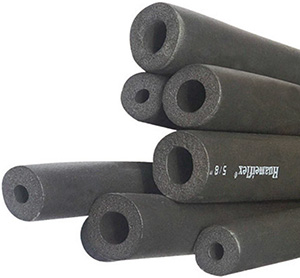
Figure 1: Foam pipe insulation
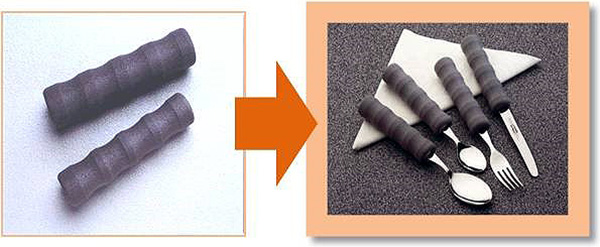
Figure 2: Built up form handles
Swivel cutleries (usually spoons) help avoid spills when scooping up your food as it keeps the spoon level as you bring it up to your mouth.
Angled cutleries assist with independent eating if you have limited wrist movements.
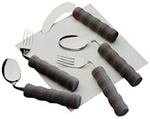
Figure 3: Angled cutleries
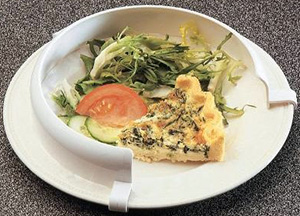
Figure 4: Plate guard

Figure 5: Deep plate with a high edge
2. Dressing
Changes to clothing and the dressing routine can reduce frustration. Give yourself time to get dressed and discover new clothing options to simplify your routine.
Take your time getting dressed. Hurrying can lead to stress, which can make Parkinson’s symptoms worse.
You may want to consider dressing during your “on” time when medication is working best.
Do a few stretching exercises before getting dressed to warm up muscles.
If one arm or leg has more stiffness, put this limb into the sleeve or pant leg first.
Sit down when dressing. Choose a chair with firm support and arms. Sitting on the edge of the bed or standing to dress can lead to loss of balance and falling.
Use a footstool and consider assistive devices like long handled shoehorns to make it easier to put on shoes and socks. Consider using elastic shoelaces or lace locks especially if you have issues with fine motor or finger movements.
Consider adaptive clothing as these are easier to manage. Adaptive clothes have modifications like magnetic buttons, bungee-cord and Velcro closures for men and women.

Figure 6: Clothing with magnetic zipper
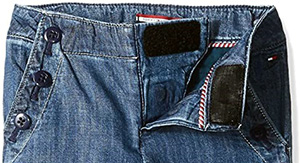
Figure 7: Clothing with velcro waist
3. Car Transfers
Car transfers can be particularly challenging for individuals with Parkinson’s Disease not only because of the symptoms but also because of the limited space that restricts the way your caregivers can assist you.

Figure 8: Swivel seat
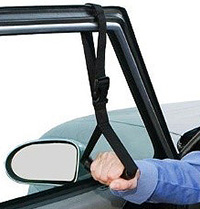
Figure 9: Car caddie
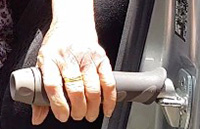
Figure 10: Metro car handle
You can consult an occupational therapist who can help you to identify the appropriate assistive devices that may simplify you daily activities.
List of Retailers (this list is not exhaustive)
Adaptive Cutleries
Adaptive clothing
Assistive Devices for Car Transfers
This information was provided by the
Singapore General Hospital (SGH)
Occupational Therapy Department, a member of the
SingHealth group.
Ref: K21
Check out other articles on parkinson's disease:
What to Do If Parkinson Disease Strikes
6 Ways People with Parkinson's Can Avoid Falls
How to Manage 'On' and 'Off' States in Parkinson's
Videos: Exercises for Parkinson Patients
Staying Active with Parkinson's
